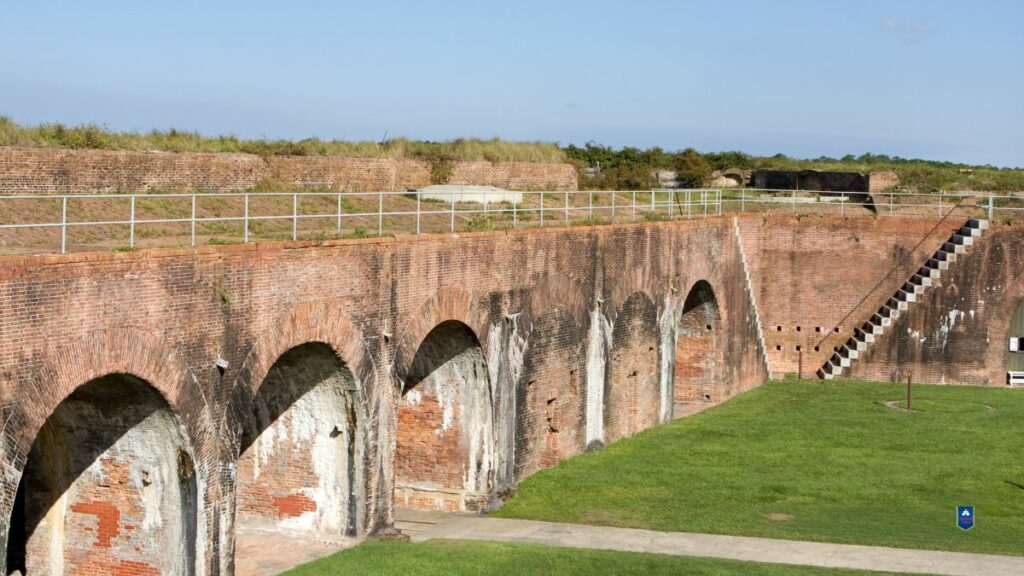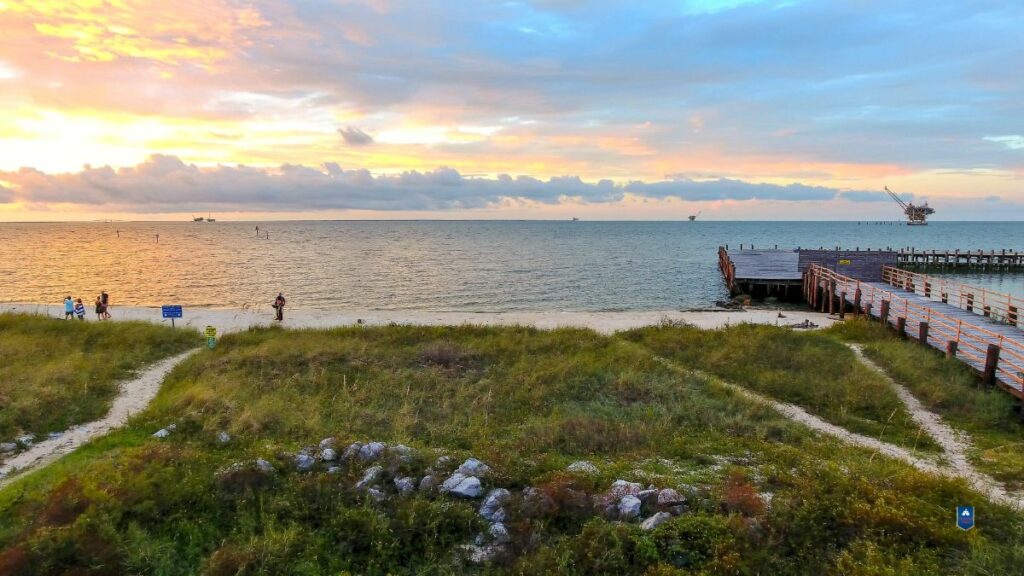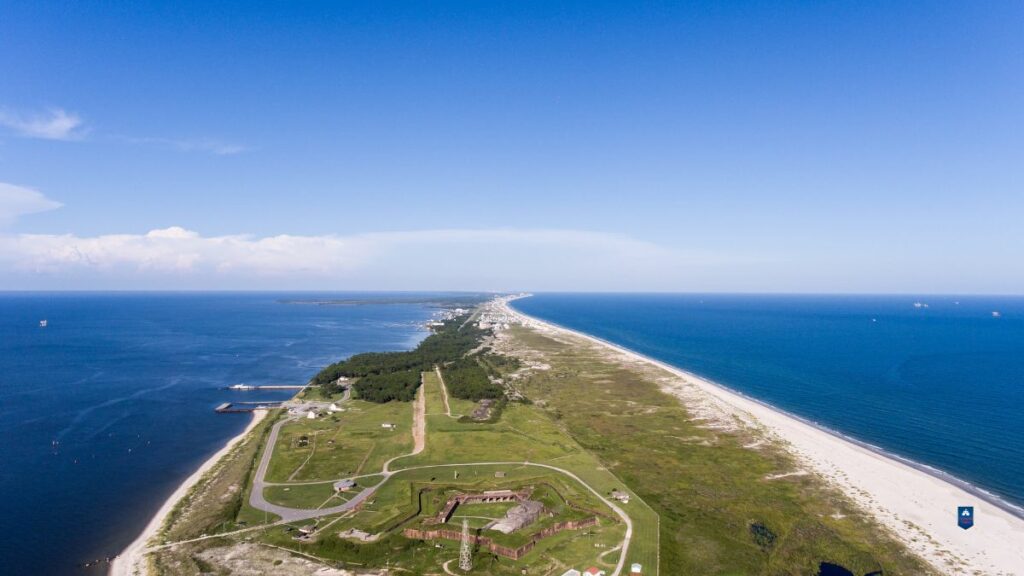Fort Morgan, Alabama, is a cornerstone of Gulf Coast heritage, reflecting centuries of military history and coastal defense.
Built in the early 19th century, this imposing fort played pivotal roles in the American Civil War and later conflicts, showcasing advancements in military engineering.
Located at the mouth of Mobile Bay, it served as a critical control point for one of the South’s busiest ports.
Today, Fort Morgan is preserved as a U.S. National Historic Landmark, inviting visitors to explore its storied past, strategic significance, and the surrounding natural beauty of the Gulf Coast.
Historic Fort Morgan in Alabama

Fort Morgan in Alabama has a storied past, marked by its strategic importance in various military conflicts.
The fort remains a significant historical site from its construction during the early 19th century to its role in the American Civil War and beyond.
Construction and Design
The construction of Fort Morgan began in 1819 and completed in 1834.
It was designed as a Third System masonry fort, a series of coastal defenses initiated by the U.S. Army Corps of Engineers.
Named after Revolutionary War hero Daniel Morgan, it features brick-and-mortar construction reinforced with earthen mounds for added defense.
Significant elements include its five bastions and a moat, intended to thwart enemy advances.
The state-of-the-art design reflected military engineering advancements to address naval threats and land assaults.
These features helped it to serve as a formidable defensive stronghold.
Strategic Military Site
Fort Morgan’s strategic location at the mouth of Mobile Bay made it invaluable for controlling access to one of the South’s busiest ports.
The fort monitored and regulated maritime traffic throughout its active use, safeguarding the bay from potential invaders.
Its position allowed for the deployment of artillery and provided a vantage point to observe and counteract enemy movements.
Due to its crucial position, the fort played a significant role in ensuring the security of Mobile, an essential hub for Confederate supplies during the Civil War.
Civil War and Battle of Mobile Bay
During the American Civil War, Fort Morgan was a Confederate stronghold. In 1864, it became central in the Battle of Mobile Bay.
Union Admiral David Farragut led a fleet that successfully breached the defenses, notably by famously ordering, “Damn the torpedoes, full speed ahead!”
The Union forces’ assault led to the eventual surrender of the Confederate soldiers stationed at the fort.
This battle was pivotal in securing Union control over the Gulf Coast, demonstrating Fort Morgan’s strategic importance and role in Civil War history.
Post-Civil War Military Use
After the Civil War, Fort Morgan’s military significance declined, but it found new relevance during the Spanish-American War and World War I.
The fort was updated to accommodate modern artillery and served as a training ground for troops.
By World War II, it was mostly a secondary coastal defense site, overshadowed by more modern facilities.
However, its historical significance ensured that it remained a symbol of military heritage and coastal defense throughout its operational period.
Modern History and Preservation
Today, Fort Morgan is a preserved historic site managed by the Alabama Historical Commission.
It is a U.S. National Historic Landmark listed on the U.S. National Register of Historic Places.
Efforts to preserve the site include tours, educational programs, and ongoing maintenance to protect its structures from environmental damage.
While no longer an active military site, it serves as a tourist destination where visitors can explore its storied past and significant role in American military history.
The commitment to its preservation helps keep the legacy of this historic fort alive for future generations.
Geographical Significance

Fort Morgan’s location offers historical and strategic importance, defined by its placement at Mobile Point and proximity to popular destinations like Gulf Shores and Dauphin Island.
Strategic Location at Mobile Point
Fort Morgan is situated at Mobile Point, controlling the entrance to Mobile Bay. This position has been crucial for maritime defense in the Gulf of Mexico.
Mobile Point acts as a guardian of Mobile Bay by providing a vantage point to monitor and control naval movements.
The fort’s strategic placement allowed it to safeguard one of the busiest ports in Alabama.
Throughout history, it played a key role in both the Civil War and World War II.
Surrounded by the Gulf of Mexico, the fort’s armaments could cover a vast expanse of water, effectively protecting the bay from enemy ships.
Proximity to Gulf Shores and Dauphin Island
Fort Morgan is also near the popular tourist destinations of Gulf Shores and Dauphin Island.
Gulf Shores is renowned for its beautiful beaches and vibrant community, attracting visitors who often explore the historical site.
Dauphin Island, a short ferry ride away, enhances the fort’s appeal, offering additional recreational opportunities and historical exploration.
Together, these sites form a cultural and recreational hub along the coastline of Alabama.
Fort Morgan’s proximity to these locales increases its accessibility and tourism potential, boosting its significance geographically and economically.
Explore More: 19 Historic Forts in Alabama
Cultural and Educational Importance
Fort Morgan, Alabama, offers a rich array of cultural and educational experiences that cater to history buffs, college students, and visitors of all ages.
This section covers interactive programs, guided and self-guided tours, and notable annual events.
Active Living History Program
The Fort Morgan State Historic Site features an Active Living History Program that brings historical periods to life.
Volunteers and staff dress in period attire and engage in various historical reenactments.
This program vividly portrays the soldiers’ lives, offering insights into their daily routines, skills, and hardships.
Interactive demonstrations include blacksmithing, musket firing, and artillery drills.
These events occur regularly, ensuring that visitors can immerse themselves in history.
Participation in these activities increases understanding of historical contexts and enhances educational value.
This living history program is especially beneficial for school trips and educational tours.
Educational Resources and Tours
Fort Morgan offers a comprehensive range of educational resources and tours.
Self-guided tour brochures are available at the visitor center, describing key points of interest within the fort.
These brochures are well-suited for those who prefer to explore independently.
Guided tours are also available for a more structured experience.
Expert guides lead groups through the fort, providing in-depth explanations of its historical significance.
These tours often cover aspects not included in self-guided options, such as lesser-known facts and anecdotes.
Additionally, Fort Morgan serves as a valuable educational resource for college students.
Professors often incorporate visits into their curriculum to offer practical, hands-on learning experiences.
These tours align well with educational goals, ensuring that students gain a well-rounded understanding of historical events.
Annual Events and Reenactments
Fort Morgan hosts several annual events that draw large crowds and offer immersive experiences.
These events often commemorate significant historical battles and periods.
Reenactments of Civil War battles are particularly popular, involving detailed portrayals of military strategies, soldier life, and the broader historical context.
Participants in these events include both staff and volunteers, many of whom are dedicated history enthusiasts.
The level of detail in these reenactments offers an authentic glimpse into history, making it an impactful learning experience.
Annual events also often feature additional activities, such as historical lectures, vendor booths selling period-appropriate items, and live music, to enhance visitors’ experiences.
Conservation and Natural Beauty

Fort Morgan, Alabama, located at the end of the scenic Fort Morgan peninsula, is a historical landmark and an area rich in natural beauty and conservation efforts.
Protected Dunes and Habitats
The protected dunes at Fort Morgan play a vital role in preserving the natural landscape and supporting local wildlife.
These dunes are safeguarded to prevent erosion and habitat loss.
Efforts by local and state organizations, including Gulf State Park, ensure that these sensitive areas are maintained and protected from human interference.
The diverse plant life, including sea oats and grasses, stabilize the dunes and provide habitat for numerous species.
Bird Watching and Fall Migration
Fort Morgan is a significant bird-watching location, particularly during the fall migration seasons.
It’s recognized as an Important Bird Area, attracting bird watchers from all over.
Migratory species stop here to rest and refuel during their long journeys.
This period offers a unique opportunity to observe various birds, including hawks, warblers, and shorebirds.
Conservation efforts support these birds by preserving their stopover habitats, ensuring a safe environment for them to thrive.
Explore More: Army Forts in Alabama
Visitors’ Experience
At Historic Fort Morgan in Alabama, visitors can enjoy various amenities and recreational activities while benefiting from accessible accommodations.
Amenities and Recreational Activities
Fort Morgan offers visitors several recreational activities and amenities.
The site boasts a picnic area with numerous tables, perfect for family outings.
Fishing enthusiasts can take advantage of the boat launch, which provides easy access to Mobile Bay.
For those who wish to explore, the nearby trails offer scenic views suitable for hiking.
A gift shop on-site provides memorabilia and essential refreshments.
Dog-friendly policies are in place, allowing pets to join in the fun.
The Mobile Bay Ferry offers additional adventure by connecting visitors with Dauphin Island, making it a great place for a day trip.
Accessibility and Accommodations
Accessibility at Fort Morgan ensures that everyone can enjoy the experience.
Wheelchair ramps and designated parking spaces are available.
The fort’s pathways are relatively smooth, though some areas may still pose challenges for those with mobility issues.
Additionally, nearby vacation rentals accommodate longer stays, each equipped with modern amenities for a comfortable visit.
The fort is open daily, making it convenient for planning trips at any time of the year.
Signage around the site provides clear directions, helping visitors navigate and make the most of their visit.
Fort Morgan in Wider Historical Context
Fort Morgan played a significant role in American military history and is comparable to other coastal defense forts in terms of design and strategic importance.
Role in American Military History
Fort Morgan is notable for its involvement in the Battle of Mobile Bay during the American Civil War.
Completed in 1834, it guarded the entrance to Mobile Bay and was used by Confederate forces.
The fort’s strategic position enabled control over the bay and was a key location for Confederate blockade runners.
The phrase “Damn the torpedoes, full speed ahead!” was famously shouted by Admiral David Farragut during the Battle of Mobile Bay in 1864.
The capture of Fort Morgan significantly disrupted Southern supply lines. Fort Morgan served as a crucial military site throughout its operational history, from the Civil War to both World Wars.
Comparison with Other Coastal Defense Forts
Fort Morgan’s design resembles other masonry coastal defense forts from the same period. Its pentagonal shape and thick brick walls are characteristic features designed to withstand artillery fire.
Fort Sumter in South Carolina and Fort Pulaski in Georgia share a similar architectural style and military purpose.
Unlike Fort Sumter, which saw the opening shots of the Civil War, Fort Morgan’s significance is tied more to naval battles.
Coastal forts like Fort Morgan were often strategically placed to protect crucial waterways and were equipped with large batteries of cannons.
Their role in defending strategic points along the coast marks them as key components in the broader system of American coastal defense.

Cory is a website owner and content creator who enjoys fishing, history, coin collecting, and sports, among other hobbies. He is a husband and father of four.
Romans 15:4 For whatever was written in former days was written for our instruction, that through endurance and through the encouragement of the Scriptures we might have hope.

